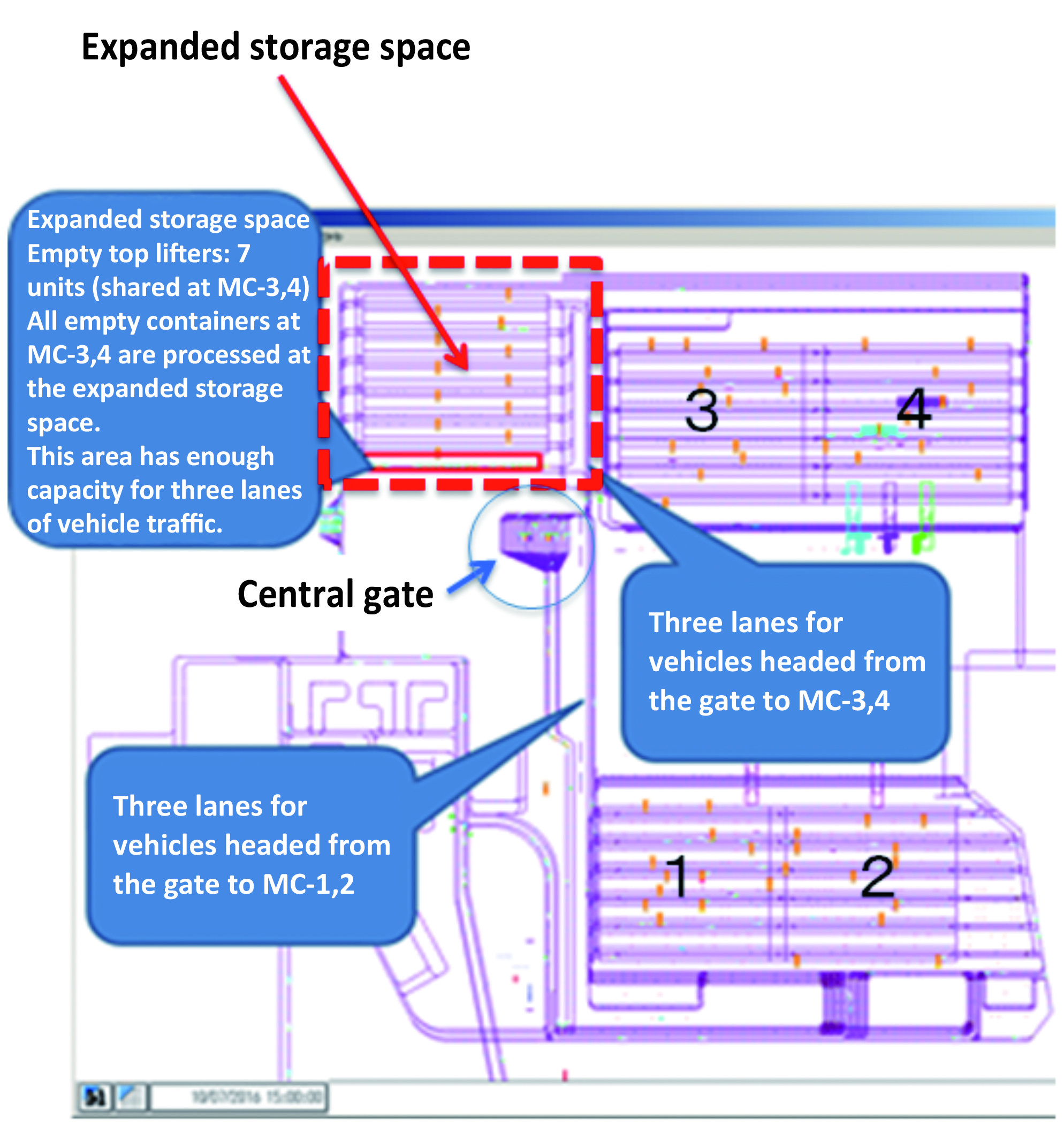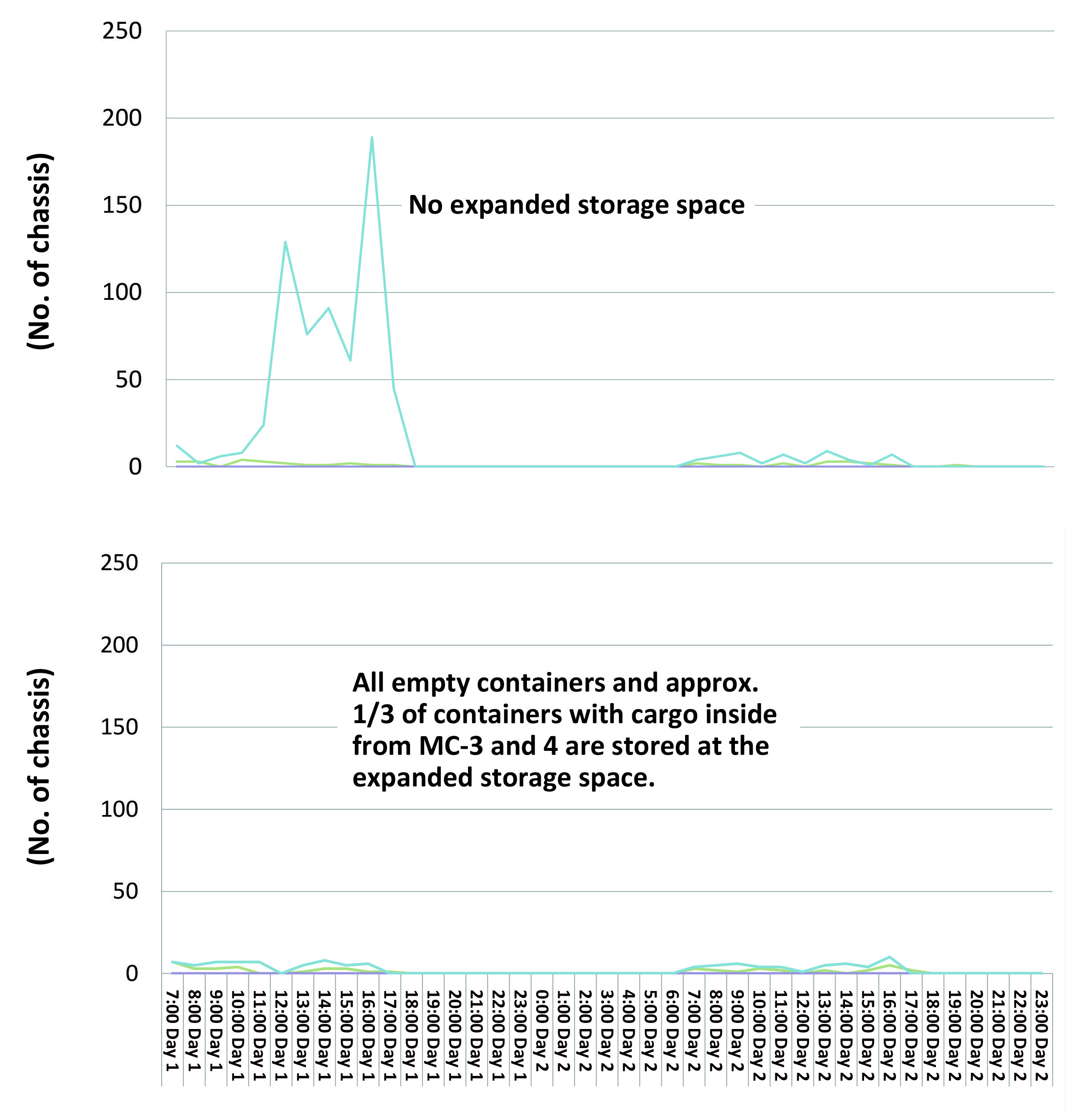On Day 1, which had a large number of chassis from outside entering the pier, a maximum of about 200 chassis were seen standing by at times, in the absence of an expanded storage space. However, once the expanded storage space was set up, the number of chassis standing by disappeared almost completely. Therefore, the provision of such expanded storage space is highly beneficial.
Major Research 2A Research on Enhancement of Port and Airport Performance for Industrial Competitiveness
Background and Objectives
Focused approaches on the following two matters are required:
- The population is decreasing, society is graying, and accumulated infrastructure is aging in Japan. In view of such problems, studies should be conducted on how to secure port and airport functions, which support the international competitiveness of Japanese industry and the vitality of the nation, and people's lives.
- With limited financial resources and workforce, studies should be conducted on how to efficiently and effectively implement maintenance, renewal, and repair works while efficiently using existing infrastructure and prolonging the life of overall facilities themselves.
Therefore, we decided to engage in research and development and other activities which are associated with improving the functions of ports and airports. In these activities, we are conducting comprehensive research and development throughout PARI on subthemes associated with international competitiveness including internationally strategic port policies and improvement of metropolitan airport functions (improvement of Haneda Airport).
The themes of this research address the development of specific technologies associated with international competitiveness including automated cargo handling and construction information modeling (CIM). Regarding development of technologies which efficiently and effectively implement the following matters for port and airport facilities, the themes of other studies (1A, 2B, and 2C) address: improvement of largescale facilities, improvement of the quake resistance of facilities, maintenance and management after facility construction, and improvement of existing facilities.
Research topics
- Development and suggestion of efficient and suitable use which contains automated cargo systems through container terminal numerical simulations for multi berths
Focusing on the strategic international container ports, we aim to establish methods for effectively utilizing container terminals that are typically limited in space in Japan. To achieve this goal, we will quantitatively evaluate the benefits of on-dock depots, how streamlined operations could prevent traffic congestion in front of the gates, and handling of large quantities of containers, and propose strategies to effectively utilize the container terminals in a comprehensive manner, using simulation-based quantitative evaluation.
- Saving labor, shortening the work period, and reducing costs by using CIM
As part of the use of construction information modeling (CIM), we will provide technical assistance concerning the construction inspection method based on construction management data utilizing multibeam sonar.
Activities in FY 2018
- Development and suggestion of efficient and suitable use which contains automated cargo systems through container terminal numerical simulations for multi berths
The operators of large-scale terminals overseas have been able to reduce costs by leveraging their scale, and have extended their technical advantages, while their general requirements are also becoming increasingly advanced, such as the reduction of negative environmental effects and the expansion and improvement of their dynamic storage capacity. Meanwhile, Japan is faced with a number of challenges that must be overcome, including limited storage space, short berth extension, comb-shaped pier arrangement, and insufficient road capacity.
To address these issues, we conducted studies on the following items with a view toward introducing ICT and other new technology:- Evaluation of the processing capacity of gates
- Estimation of the effects of improving operation efficiency by utilizing ICT, etc., and the effects of introducing a reservation system and a prior gate processing system
- Rational handling of cargo quantities that exceed plans
Proposal to utilize expanded storage space (empty containers, containers with cargo inside, on-dock)
We selected Minami Honmoku Pier MC-1 through 4 of Yokohama Port to conduct a simulation-based quantitative evaluation. In the expanded storage space, we were able to confirm significant benefits already on day 1 (on which there was a relatively large number of chassis from outside entering the pier), in terms of the number of chassis standing by in the machinery parking area in front of the gate.

Typical case of the simulation model




